Robert Textile Recycling Project
36 Pages8309 Words69 Views
Added on 2023-06-11
About This Document
This report discusses the urgency of textile recycling, the business development process, advantages of recycling, and more in Robert Textile Recycling Project. It includes a detailed discussion of the textile recycling process, sorting, and conversion of textile materials to new products. The report also covers the entrepreneurial sustainability in Nigeria and how Robert Textile Recycling can help in business development. The subject is IMA7002 and the college/university is not mentioned.
Robert Textile Recycling Project
Added on 2023-06-11
ShareRelated Documents
IMA7002
Research Tittle:
Robert Textile Recycling Project
Research Tittle:
Robert Textile Recycling Project

2
Table of content
Introduction .................................................................................................................................. 3
The urgency to textile recycling ....................................................................................................6
Example ....................................................................................................................................... 7
Business Development Process ................................................................................................... 9
Textile recycling process .............................................................................................................14
Pre-consumer waste ...................................................................................................................14
Post-consumer waste ................................................................................................................. 15
Processes .................................................................................................................................... 16
Sorting ........................................................................................................................................ 16
Crude sorting .............................................................................................................................. 17
Second-hand clothing exportation markets ................................................................................17
Conversion of textile materials to new products ........................................................................17
Advantages of recycling ..............................................................................................................18
Methods of textile recycling, ......................................................................................................18
● Mechanical .............................................................................................................................. 18
● Chemical .................................................................................................................................. 19
Recycling strategies for textiles ..................................................................................................19
Nigeria’s dying textile industry ...................................................................................................20
Entrepreneurial Sustainability in Nigeria ....................................................................................23
Business Development with the Help of Robert Textile .............................................................23
Business development through sustainability in the textile industry .........................................23
Conclusion .................................................................................................................................. 27
References .................................................................................................................................. 29
Table of content
Introduction .................................................................................................................................. 3
The urgency to textile recycling ....................................................................................................6
Example ....................................................................................................................................... 7
Business Development Process ................................................................................................... 9
Textile recycling process .............................................................................................................14
Pre-consumer waste ...................................................................................................................14
Post-consumer waste ................................................................................................................. 15
Processes .................................................................................................................................... 16
Sorting ........................................................................................................................................ 16
Crude sorting .............................................................................................................................. 17
Second-hand clothing exportation markets ................................................................................17
Conversion of textile materials to new products ........................................................................17
Advantages of recycling ..............................................................................................................18
Methods of textile recycling, ......................................................................................................18
● Mechanical .............................................................................................................................. 18
● Chemical .................................................................................................................................. 19
Recycling strategies for textiles ..................................................................................................19
Nigeria’s dying textile industry ...................................................................................................20
Entrepreneurial Sustainability in Nigeria ....................................................................................23
Business Development with the Help of Robert Textile .............................................................23
Business development through sustainability in the textile industry .........................................23
Conclusion .................................................................................................................................. 27
References .................................................................................................................................. 29

3
Introduction
Business Development might be summarized through a few ideas,
initiatives, and activities that may produce a business better. Including
increasing profits, development in relation to business growth, and
increasing profitability by making proper relationships, and making proper
business decisions.
Roberts Recycling Ltd started by Friends Simon and Steve Roberts in 2009,
has because grown into on the list of UK's premier textile recycling
organizations, control over 200 tonnes of clothing each month and releasing
during Europe, Africa, and the Centre East.
The recent facets of the company are primarily charity textile recycling, style
retail textile recycling, and school textile recycling, and local authority textile
recycling. And is definitely an award-winning, family-run textile recycling
company-specific to buying, gathering, and exporting unwelcome clothes.
The principle of the firm is to divert waste from landfills, but we also
pleasure ourselves in delivering economical clothing to poorer areas of the
entire world beyond your UK.
The company gathers and markets tonnes of unwelcome clothing each week
to merely support colleges, charities, and different businesses to boost
much-needed funds. Roberts, S., and J. (2009)
To understand why it is important that the urgent recycling of textiles can
recover and develop certain businesses all over the world. It can be
understood that the necessary steps that are represented by the association
Introduction
Business Development might be summarized through a few ideas,
initiatives, and activities that may produce a business better. Including
increasing profits, development in relation to business growth, and
increasing profitability by making proper relationships, and making proper
business decisions.
Roberts Recycling Ltd started by Friends Simon and Steve Roberts in 2009,
has because grown into on the list of UK's premier textile recycling
organizations, control over 200 tonnes of clothing each month and releasing
during Europe, Africa, and the Centre East.
The recent facets of the company are primarily charity textile recycling, style
retail textile recycling, and school textile recycling, and local authority textile
recycling. And is definitely an award-winning, family-run textile recycling
company-specific to buying, gathering, and exporting unwelcome clothes.
The principle of the firm is to divert waste from landfills, but we also
pleasure ourselves in delivering economical clothing to poorer areas of the
entire world beyond your UK.
The company gathers and markets tonnes of unwelcome clothing each week
to merely support colleges, charities, and different businesses to boost
much-needed funds. Roberts, S., and J. (2009)
To understand why it is important that the urgent recycling of textiles can
recover and develop certain businesses all over the world. It can be
understood that the necessary steps that are represented by the association
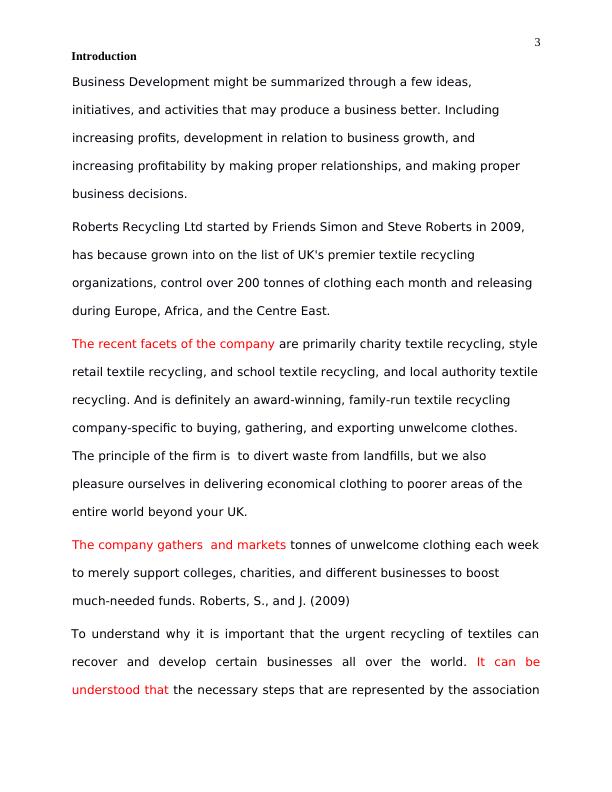
4
of smart analysis into the textile recycling industry. There are certain
processes that involve textile recycling by the involved process of collection
sorting and processing of certain textiles or donating them for the
subsequent users. It's also important to understand the basis of the growing
industry such as textile recycling and recovery units to balance its production
and distribution (Hofverberg & Maivorsdotter, 2018).
Is very important for the textile industry to have a recycling industry
consisting of clothing and other materials in relation to textile because the
textile industry now is nearly 1 trillion US dollars in worth globally. If this
goes on then people are going to buy more and more material for textile in a
sense in the coming years but producing textile has a lot of side effects on its
environment because of the chemicals that are used on it and those
chemicals get disposed of in the environment through industrial waste and
toxic fumes (Sandvik & Stubbs, 2019).
This is one of the reasons that the urgency of recycling textiles is at its peak
because now the technology and the processes with which the textiles are
worn can be disposed of and recycled are available to be used for
subsequent garment strand by strand and much useful cleaning materials for
leisure equipment can be woven out of it (Piribauer & Bartl, 2019).
of smart analysis into the textile recycling industry. There are certain
processes that involve textile recycling by the involved process of collection
sorting and processing of certain textiles or donating them for the
subsequent users. It's also important to understand the basis of the growing
industry such as textile recycling and recovery units to balance its production
and distribution (Hofverberg & Maivorsdotter, 2018).
Is very important for the textile industry to have a recycling industry
consisting of clothing and other materials in relation to textile because the
textile industry now is nearly 1 trillion US dollars in worth globally. If this
goes on then people are going to buy more and more material for textile in a
sense in the coming years but producing textile has a lot of side effects on its
environment because of the chemicals that are used on it and those
chemicals get disposed of in the environment through industrial waste and
toxic fumes (Sandvik & Stubbs, 2019).
This is one of the reasons that the urgency of recycling textiles is at its peak
because now the technology and the processes with which the textiles are
worn can be disposed of and recycled are available to be used for
subsequent garment strand by strand and much useful cleaning materials for
leisure equipment can be woven out of it (Piribauer & Bartl, 2019).
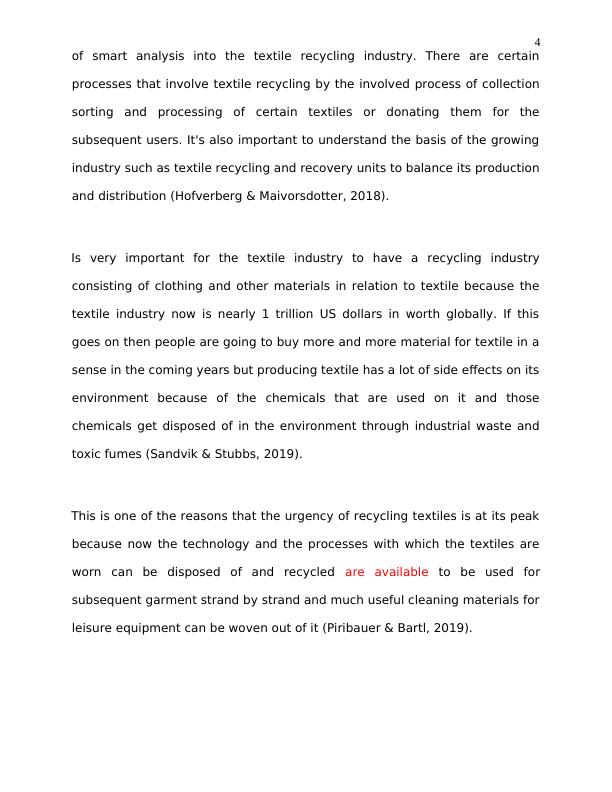
5
Hence textile recycling can be defined as a particular process in which
different waste products can be collected from the disposed textiles
producers other find textile materials are fabrics in process of which it can be
materialized or used as a source of different processes system this source
and spotted processed yarns of textile can be conditioned and composite it
into an entirely different material which can be resold for its value. This way
there is a controlled production of textile in a certain area and also not many
toxic fumes. These are produced or released in the atmosphere along with
which lesser chemical dyes are used in Robert Recycling Limited which
saves the waterways by which the industries disposal of their chemical waste
(Leal Filho & Balogun, 2019).
It is very much true that it is a modern concept but it is trending because of
the overconsumption of textile that can be seen in this generation because
of the global fashion culture being at its very peak. UK-based companies
such as Roberts recycling limited in Liverpool solely focus on initiatives that
help the entire country a lot (Hofverberg & Maivorsdotter, 2018).
In this report, the discussion will focus on recent trends of overconsumption
and why the urgency of improving Robert textile recycling is at its peak. The
report will provide detailed discussion deep within the Robert textile
recycling processes and what cause of development does Robert textile
recycling bring into the development of new businesses and the textile
industry in general first we will also be discussing how Robert textile
Hence textile recycling can be defined as a particular process in which
different waste products can be collected from the disposed textiles
producers other find textile materials are fabrics in process of which it can be
materialized or used as a source of different processes system this source
and spotted processed yarns of textile can be conditioned and composite it
into an entirely different material which can be resold for its value. This way
there is a controlled production of textile in a certain area and also not many
toxic fumes. These are produced or released in the atmosphere along with
which lesser chemical dyes are used in Robert Recycling Limited which
saves the waterways by which the industries disposal of their chemical waste
(Leal Filho & Balogun, 2019).
It is very much true that it is a modern concept but it is trending because of
the overconsumption of textile that can be seen in this generation because
of the global fashion culture being at its very peak. UK-based companies
such as Roberts recycling limited in Liverpool solely focus on initiatives that
help the entire country a lot (Hofverberg & Maivorsdotter, 2018).
In this report, the discussion will focus on recent trends of overconsumption
and why the urgency of improving Robert textile recycling is at its peak. The
report will provide detailed discussion deep within the Robert textile
recycling processes and what cause of development does Robert textile
recycling bring into the development of new businesses and the textile
industry in general first we will also be discussing how Robert textile
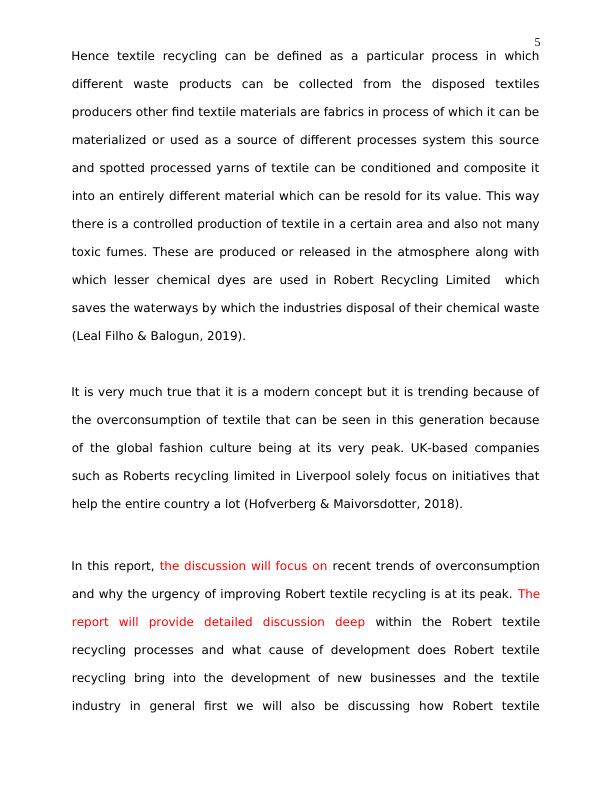
6
recycling bills sustainability and what are the limitations towards Robert
textile recycling. In addition to this discussion on how clothing retailers have
embraced the recycling efforts in recent times and advertised their recycled
textile materials in accordance to shift the consumer's expectations and
consumers' belief of saving the environment into a viable consumer product
(Sandvik & Stubbs, 2019).
The urgency to textile recycling
The urgency of improving Robert textile recycling is because it is very
important to estimate how much of waste is being re-incorporated towards
the environment and the atmosphere just because practically for the reason
of the fashion statement people are constantly buying textiles without its
emergence of need. Estimation is that there are more than a hundred billion
governments that are produced annually all over the world out of which only
17 million are recycled. But to produce this estimated 100 billion
governments annually that is more than 70 million waste as municipal solids
and atmosphere toxic fumes that are produced which cannot be
contemplative in the future (Piribauer & Bartl, 2019).
It is also true that the rate of recycling especially for textiles has also derived
from the list of equipment that can be made from the recycling material of
textile developed into your and can produce a lot of materials. It is also
estimated in a survey that 15.8 % of the total waste produced all over the
recycling bills sustainability and what are the limitations towards Robert
textile recycling. In addition to this discussion on how clothing retailers have
embraced the recycling efforts in recent times and advertised their recycled
textile materials in accordance to shift the consumer's expectations and
consumers' belief of saving the environment into a viable consumer product
(Sandvik & Stubbs, 2019).
The urgency to textile recycling
The urgency of improving Robert textile recycling is because it is very
important to estimate how much of waste is being re-incorporated towards
the environment and the atmosphere just because practically for the reason
of the fashion statement people are constantly buying textiles without its
emergence of need. Estimation is that there are more than a hundred billion
governments that are produced annually all over the world out of which only
17 million are recycled. But to produce this estimated 100 billion
governments annually that is more than 70 million waste as municipal solids
and atmosphere toxic fumes that are produced which cannot be
contemplative in the future (Piribauer & Bartl, 2019).
It is also true that the rate of recycling especially for textiles has also derived
from the list of equipment that can be made from the recycling material of
textile developed into your and can produce a lot of materials. It is also
estimated in a survey that 15.8 % of the total waste produced all over the
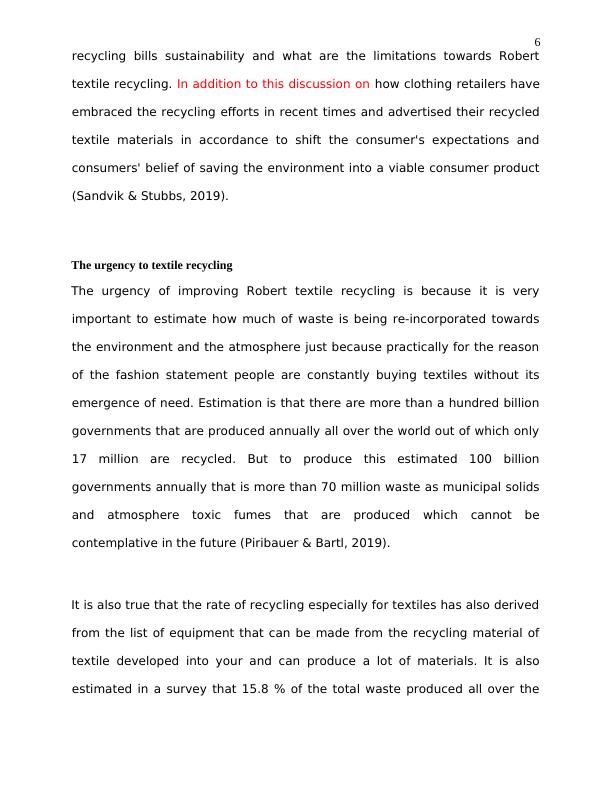
7
world can be reduced if annually Robert textile recycling grosses 60% of its
validity. It is also true that Robert textile recycling offers many benefits to
the environment (Harmsen & Bos, 2021).
Example
If any new garment which is disposed of is easily created by the environment
or by nature it is wrong. The virgin fibres that are disposed of go into the
landfills and cannot be produced anymore into recycled textiles but just get
talked into the layers of soil for decades before degradation. This is the
reason that if textile production is reduced and Robert textile recycling are
increased then the consumption of the waste in the landfill spaces would
have its time for degradation. But at the rate that the textiles are being
manufactured, the required space and time of the land fields to naturally
decompose such natural or synthetic materials are being reduced because of
which more and more energy and water are being used for the production of
textiles and degradation of textiles (Leal Filho & Balogun, 2019).
Also, textile recycling provides the purpose for understanding how much the
manufacturing of textiles globally has served the purpose of pollution and
waste accumulating in the environment. Hence recycling would provide a
purpose to avoid such pollution and lessen the production of dyes that are
very harmful to the environment as they are pure chemical waste products
world can be reduced if annually Robert textile recycling grosses 60% of its
validity. It is also true that Robert textile recycling offers many benefits to
the environment (Harmsen & Bos, 2021).
Example
If any new garment which is disposed of is easily created by the environment
or by nature it is wrong. The virgin fibres that are disposed of go into the
landfills and cannot be produced anymore into recycled textiles but just get
talked into the layers of soil for decades before degradation. This is the
reason that if textile production is reduced and Robert textile recycling are
increased then the consumption of the waste in the landfill spaces would
have its time for degradation. But at the rate that the textiles are being
manufactured, the required space and time of the land fields to naturally
decompose such natural or synthetic materials are being reduced because of
which more and more energy and water are being used for the production of
textiles and degradation of textiles (Leal Filho & Balogun, 2019).
Also, textile recycling provides the purpose for understanding how much the
manufacturing of textiles globally has served the purpose of pollution and
waste accumulating in the environment. Hence recycling would provide a
purpose to avoid such pollution and lessen the production of dyes that are
very harmful to the environment as they are pure chemical waste products
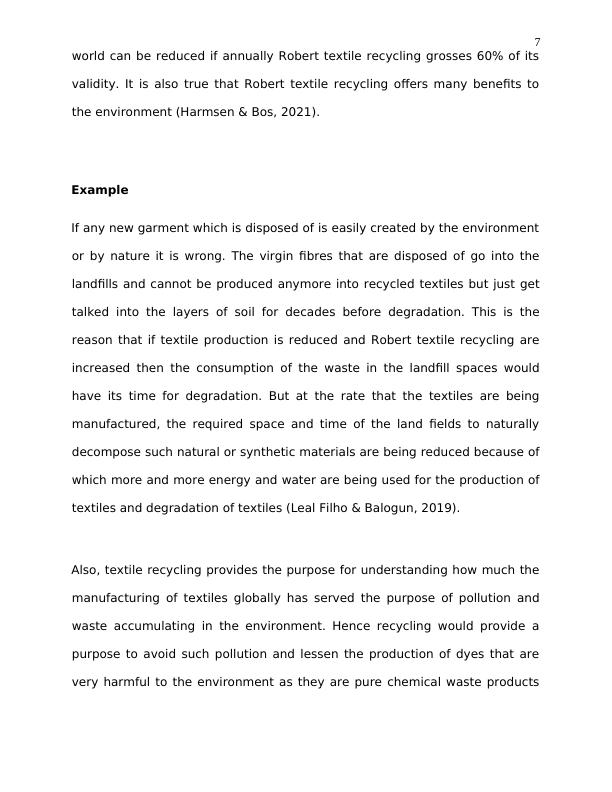
8
that cannot be under any influence which would result in their degradation.
So they sit in the topmost layer of soil and water making them infertile and
rotten in nature (Hofverberg & Maivorsdotter, 2018).
The urgency of Robert textile recycling and examples of real and footwear
industries can be taken into consideration. Imperial and footwear industries
have accounted for 8% of the global greenhouse emissions and equal the
entire European Union's admission in a month. It also takes up more than
2700 litres of water to process the making of one t-shirt. It's three year worth
of fresh drinking water for one person which is wasted for making one t-shirt.
North Americans are shipping and using 10.5 million tons of clothing every
year out of which 8.3 million tonnes and up in the landfills every year where
95% of those materials are recyclable but are not recycled (Sandvik &
Stubbs, 2019).
In 2014 it also showed that consumer’s bot 60% of the closings more than
the average surface review and also threw away the governments twice as
fast as any of the year. Thankfully there is an ultimatum given by the United
Nations climate goals for a more sustainable and transforming apparel
industry for adapting the regulators of these fashion industries with
reference and consideration for the environment. Finding new ways of mixing
the government materials extracted from the old worn textiles which are
that cannot be under any influence which would result in their degradation.
So they sit in the topmost layer of soil and water making them infertile and
rotten in nature (Hofverberg & Maivorsdotter, 2018).
The urgency of Robert textile recycling and examples of real and footwear
industries can be taken into consideration. Imperial and footwear industries
have accounted for 8% of the global greenhouse emissions and equal the
entire European Union's admission in a month. It also takes up more than
2700 litres of water to process the making of one t-shirt. It's three year worth
of fresh drinking water for one person which is wasted for making one t-shirt.
North Americans are shipping and using 10.5 million tons of clothing every
year out of which 8.3 million tonnes and up in the landfills every year where
95% of those materials are recyclable but are not recycled (Sandvik &
Stubbs, 2019).
In 2014 it also showed that consumer’s bot 60% of the closings more than
the average surface review and also threw away the governments twice as
fast as any of the year. Thankfully there is an ultimatum given by the United
Nations climate goals for a more sustainable and transforming apparel
industry for adapting the regulators of these fashion industries with
reference and consideration for the environment. Finding new ways of mixing
the government materials extracted from the old worn textiles which are
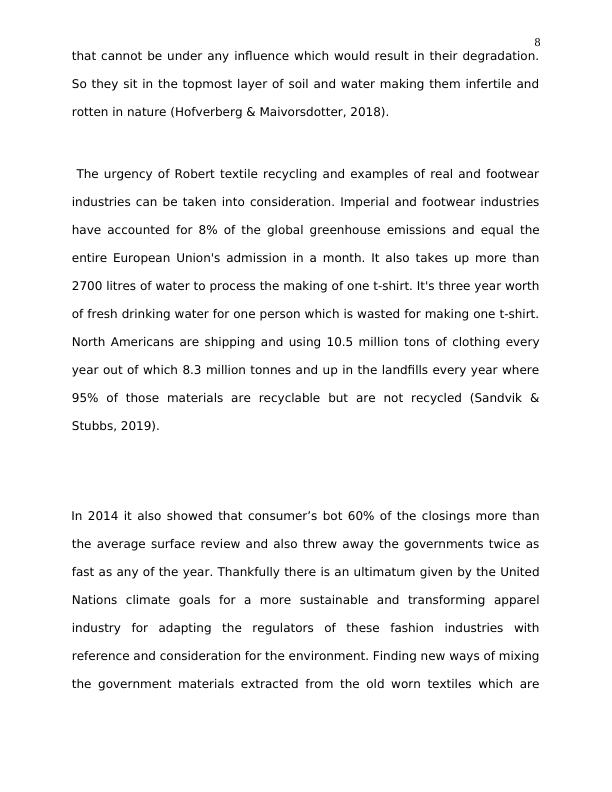
End of preview
Want to access all the pages? Upload your documents or become a member.
